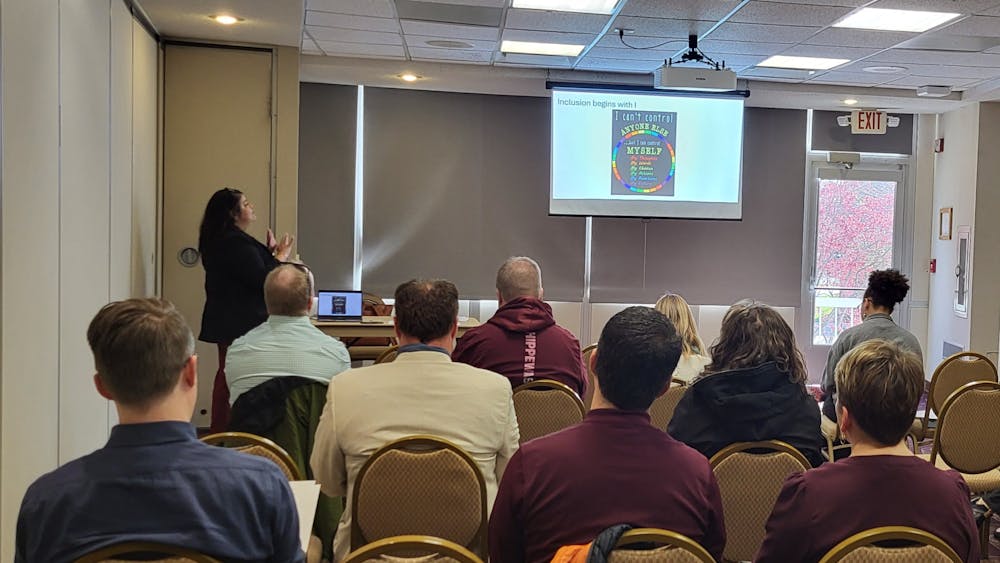(dis)ABLED BEAUTY grand opening sparks conversation about inclusive fashion

Almost 200 people gathered in Charles V. Park Library the night of Feb. 8 for the grand opening of the Clarke Historical Library's newest exhibit: (dis)ABLED BEAUTY.
The event comprised speeches, presentations and a design competition to celebrate inclusive fashion. Both the Park Library Auditorium and the Baber Room had every seat filled for viewing of the event. The event was also live-streamed online through the Clarke Historical Library webpage.
Heidi McKenzie, a wheelchair-adaptive clothing designer, gave the opening speech. McKenzie was in a car accident in 2007 that left her in a wheelchair.
She won Ms. Wheelchair Kentucky in 2012 and competed in Ms. Wheelchair America that same year. It was at Ms. Wheelchair America when she was inspired to get into the fashion industry. McKenzie met dozens of women in that pageant who had the same struggles she did: finding comfortable and fashionable clothing.
"I wondered, why was all adaptable clothing for the elderly?" McKenzie said. "I don't want to look like my grandma, and I don't want to have to wear sweatpants all the time."
McKenzie started a clothing company, Alter Ur Ego, which features jeans designed for specifically for wheelchair users. The jeans have a high back rise, elastic waistband, easy-access thigh pockets and a longer inseam.
McKenzie described her struggles getting into the fashion industry.
"The fashion industry is like 'Mean Girls -- If you're not in, you're out," McKenzie said. "You have to know their lingo, so you don't seem like an amateur. It's a hard industry, but if you're a good talker, you're in."
Once she got into the fashion industry, however, she faced a bigger issue: reaching her target market.
"Finding a way to reach just my target market has been a struggle," McKenzie said. "I'm still trying to figure out, is it a big enough market to sustain a business? Is my price point affordable for people with disabilities, who are usually on fixed incomes? Since I'm on my own, I'm still trying to figure out where to go next."
Dorr freshman Courtney Johnson said she was touched by McKenzie's speech. She said it was a great way to look into the life of someone with a disability.
"There are so many things people never even think about when it comes to the struggles people with disabilities face," Johnson said. "People never think about little things like finding a good pair of jeans. This exhibition is opening a door for people who never thought of this as an issue and making (Central Michigan University) a more accepting place."
Following McKenzie's speech was a presentation from graduate student Alexis Jones. She won the 2017 "Concept 2 Consumer" Merchandising Competition, which is put on by the American Association of Textile Chemists and Colorists. Her clothing line, Moxie, was designed for children with tactile issues and sensitive skin conditions.
Jones put together a business concept with Moxie and junior Danni Chen, a fashion student created prototypes of Jones' designs. The prototypes were modeled by three young girls during the presentation.
Ian Mull, faculty advisor for Threads fashion show, and three producers of the 2018 Threads fashion show announced the winners of the (dis)ABLED BEAUTY Design Competition.
Eight students embellished prosthetic limbs which were donated by Springer Prosthetic and Orthotic Services. The top three designs were chosen by a 5-person jury, and the community could vote for their favorite design using Snapchat.
The Department of Physical Medicine and Rehabilitation at Michigan State University donated $700 to be used as prize money.
The winners were:
- First Place: Cecilia Alfaro
- Second Place: Walled Lake junior Tiffany Griffiths and junior Kathryn Montgomery
- Third Place: graduate student Jason Gagnon
- Viewer's Choice: Grand Blanc senior Cecilia Alfaro
Alfaro's design included pieces of a broken mirror glued together. A small panel included a written statement about her inspiration for the design.
Her statement said, "what this prosthetic leg is all about (is) taking what may seem broken but putting all the pieces together to make a beautiful new creation."
All eight designs can be viewed in the display case in Park Library until Feb. 16.
The exhibition in Clarke Historical Library included a broad range of adaptive and assistive pieces. Some were conceptual, like a dress adorned with copper wire and hearing aid batteries. Others were functional, including wheelchair-adaptive clothing and fashionable hearing aid covers.
Big Rapids doctoral student Jacob Swanson is an audiology student who has taken several classes from audiology professor and co-curator of the exhibition Stacey Lim. Swanson said Lim has been giving him and his classmates updates about the project since it was first showcased at Kent State University in 2016. He said seeing the exhibition in person was not what he expected.
"It was a much broader scope than I thought it would be," Swanson said. "In audiology, we talk about hearing loss, so I expected to see hearing aids and cochlear implants, but I was impressed with the scope. The exhibition included disabilities of all kinds."
(dis)ABLED BEAUTY will be open for viewing in Clarke Historical Library until August 2018.




